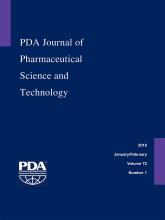Abstract
A real-time polymerase chain reaction (RT-PCR) assay was developed to detect Burkholderia cepacia in pharmaceutical products contaminated with low levels of bacteria. Different pharmaceutical suspensions were artificially contaminated with B. cepacia, Escherichia coli, Staphylococcus aureus, and Bacillus megaterium. After a 24 h incubation in trypticase soy broth with Tween 20, samples were streaked on mannitol salt, phenyl ethyl alcohol, eosin methylene blue, MacConkey, and pseudomonas isolation agar. Microbial DNA was extracted from each sample by using a Tris-EDTA, proteinase K, Tween 20 buffer. Regular PCR targeting the 1.5 kilobases 16S rRNA eubacterial gene and cloning showed the predominant DNA in the extracted mix belonged to E. coli. Selective media isolation of bacterial contamination showed B. cepacia only detected on pseudomonas isolation while eosin methylene blue and MacConkey detected only E. coli. RT-PCR using primers PSL1 and PSR1 amplified a 209 bp 16S rRNA fragment using a Roche LightCycler 96® system with SYBR green I, a common double-stranded binding dye. The cycle at which fluorescence from amplification exceeds the background fluorescence was referred to as quantification cycle. All samples were found to be positive by standard microbiological testing and RT-PCR. B. cepacia was detected within 30 h in all contaminated samples using RT-PCR. Based upon standard curve analysis of B. cepacia DNA, the minimum DNA concentration that could be detected was 10 fg/uL with a correlation value of 0.98. RT-PCR detection of B. cepacia allowed faster quality control analysis, corrective actions, and process optimization.
LAY ABSTRACT: A real-time polymerase chain reaction (RT-PCR) assay was developed to detect Burkholderia cepacia in pharmaceutical products contaminated with low levels of bacteria. B. cepacia is the number one reason for microbial contamination recalls of non-sterile drug products in the USA. RT-PCR using primers PSL1 and PSR1 amplified a 209 bp 16S rRNA fragment using a Roche LightCycler 96® system with SYBR green I, a common double-stranded binding dye. All samples were found to be positive by standard microbiological testing and RT-PCR. B. cepacia was detected within 30 h in all contaminated samples using RT-PCR. RT-PCR detection of B. cepacia allowed faster quality control analysis, corrective actions, and process optimization.
- © PDA, Inc. 2018
PDA members receive access to all articles published in the current year and previous volume year. Institutional subscribers received access to all content. Log in below to receive access to this article if you are either of these.
If you are neither or you are a PDA member trying to access an article outside of your membership license, then you must purchase access to this article (below). If you do not have a username or password for JPST, you will be required to create an account prior to purchasing.
Full issue PDFs are for PDA members only.
Note to pda.org users
The PDA and PDA bookstore websites (www.pda.org and www.pda.org/bookstore) are separate websites from the PDA JPST website. When you first join PDA, your initial UserID and Password are sent to HighWirePress to create your PDA JPST account. Subsequent UserrID and Password changes required at the PDA websites will not pass on to PDA JPST and vice versa. If you forget your PDA JPST UserID and/or Password, you can request help to retrieve UserID and reset Password below.






